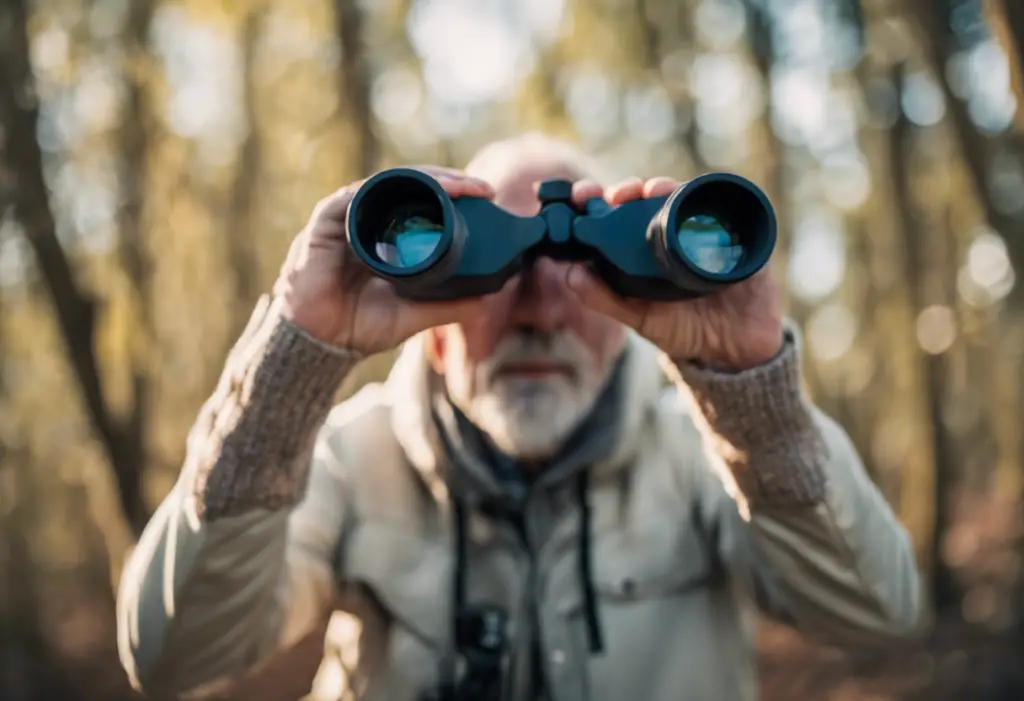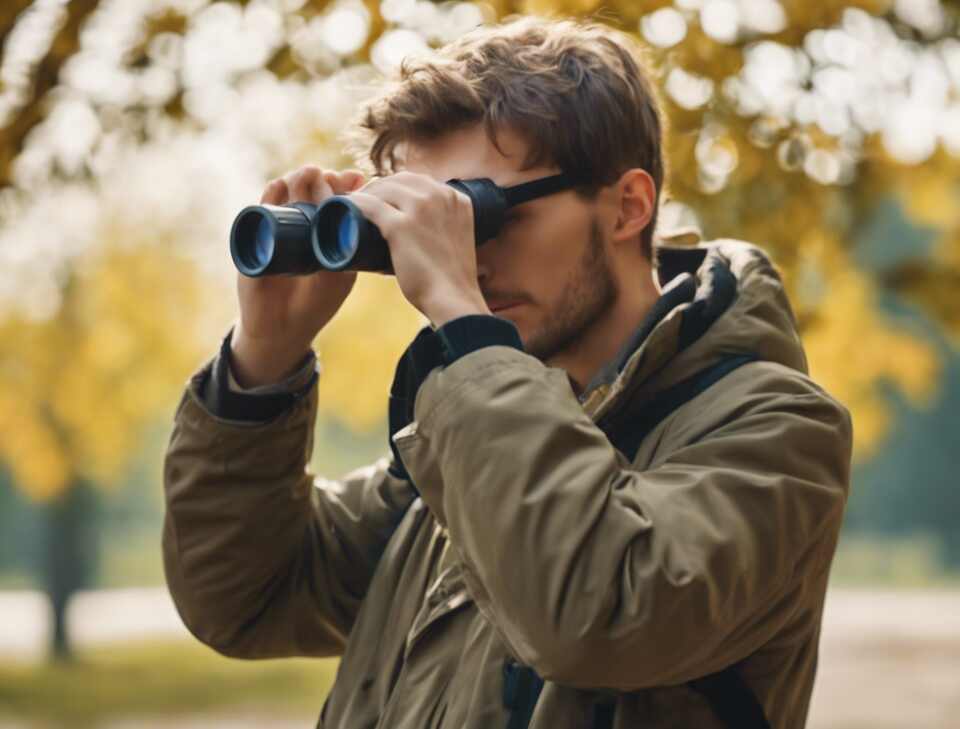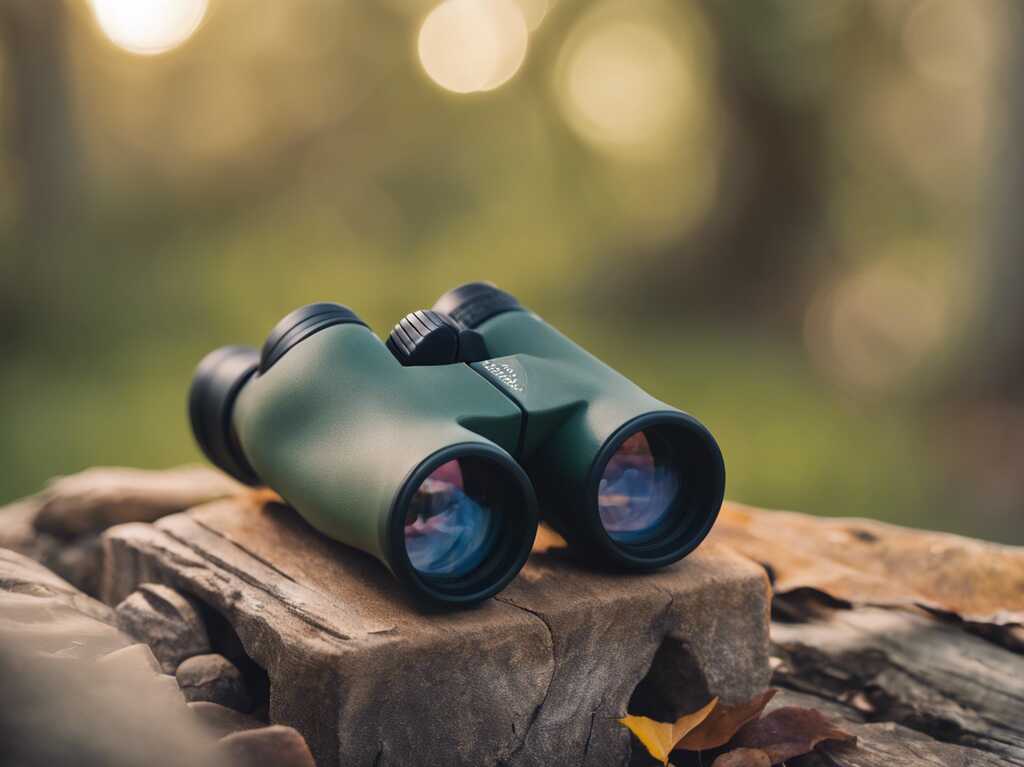
Welcome to the ultimate guide for bird enthusiasts! Whether you’re a seasoned birder or just beginning your journey into the captivating world of backyard birding, having the right pair of binoculars can make all the difference. In this comprehensive review, we dive into the top contenders for the title of the ‘Best Binoculars for Backyard Birding in 2024.’
From crystal-clear optics to ergonomic designs, we explore the features that matter most for enhancing your birdwatching experience. So grab your binoculars and join us as we embark on a journey to discover the perfect optics companion for your avian adventures right in your own backyard.
Table of Contents
The 5 Best Binoculars for Backyard Birding
Uncover a handpicked lineup of the finest binoculars, meticulously selected to enhance your backyard birding adventures with precision and clarity.
Nikon Monarch 5 8×42
The Nikon Monarch 5 8×42 binoculars are a top choice for backyard birding enthusiasts. With their powerful 8x magnification and impressive 42mm objective lenses, these binoculars offer exceptional clarity and brightness, even in low-light conditions. The multicoated optics and dielectric high-reflective prism coatings ensure vibrant, true-to-life color reproduction, allowing you to admire the intricate details of your feathered friends.
One of the standout features of the Monarch 5 is its rugged and waterproof construction, making it a reliable companion even in inclement weather. The ergonomic design and lightweight build (20.8 oz) ensure comfortable extended use, perfect for long birding sessions in your backyard.
Pros:
- Provides high-end optical quality and impressive brightness for the price range.
- Sturdy, comfortable, and compact design with a grippy rubber coating.
- Smooth and easy-to-use focus knob.
- Relatively lightweight at 24.2 oz (687 g), about 1.5 oz lighter than average for 8×42 binoculars.
Cons:
- Narrower field of view compared to other top models, which can make it harder to find and track birds.
- Focus wheel may feel a bit stiff to some users.
Verdict:
The Nikon Monarch 5 8×42 binoculars offer excellent value, delivering high-quality optics and a durable, comfortable design at a reasonable price point. While the narrower field of view may be a drawback for some users, the overall performance and features make these binoculars a great choice, especially for those new to birding or looking for an affordable yet capable pair of full-size binoculars. See the Nikon Monarch 7 on Amazon for pricing and reviews.
Celestron Trailseeker ED 8×42
The Celestron Trailseeker ED 8×42 binoculars are a fantastic choice for backyard birding, offering exceptional optical performance and durability. The use of extra-low dispersion (ED) glass in the objective lenses helps to minimize chromatic aberration, resulting in crisp, high-contrast images with vivid color rendition.
With an 8x magnification and 42mm objective lenses, the Trailseeker ED provides a balance of power and field of view, making it easy to spot and track birds in your backyard. The rubber-armored body ensures a secure and comfortable grip, even in wet or slippery conditions.
Additionally, the binoculars are nitrogen-purged and O-ring sealed, making them waterproof and fogproof, ensuring reliable performance in various weather conditions.
Pros:
- Good overall optical quality and clarity, with above average image sharpness.
- Bright image in most lighting conditions.
- Comfortable to hold, with a compact and durable design.
- Wide field of view for the magnification.
- Waterproof and fog-proof construction.
- Includes useful accessories like a harness strap.
Cons:
- Image clarity and brightness not quite as good as some competitors in the same price range.
- Some minor chromatic aberration/color fringing visible around bright objects like the moon.
- Magnification may be too low for serious deep-sky astronomy use.
- Carry case cannot accommodate the included harness strap.
Verdict:
The Celestron TrailSeeker ED 8×42 binoculars offer a good balance of optical quality, durability, and portability at a reasonable price point. While they don’t quite match the performance of top-tier models, they provide a solid user experience for activities like birdwatching, hiking, and casual stargazing. The compact, waterproof design makes them a versatile choice for outdoor enthusiasts. See the Celestron TrailSeeker ED on Amazon for pricing and reviews.
Leupold BX-2 Alpine 10×42
For backyard birders seeking even greater magnification, the Leupold BX-2 Alpine 10×42 binoculars are a top contender. The 10x magnification provides a closer, more detailed view of your feathered visitors, allowing you to observe their behaviors and plumage characteristics with remarkable clarity.
Despite the powerful magnification, the BX-2 Alpine maintains a wide field of view, making it easier to track and follow birds in motion. The lenses are fully multicoated, delivering exceptional light transmission and contrast, resulting in vibrant and accurate color representation.
The binoculars’ rugged and lightweight aluminum body, combined with a waterproof and fogproof design, make them a durable and reliable choice for backyard birding in any weather.
Pros:
- Improved optical prescription compared to the BX-1 series, delivering a clearer and crisper image.
- Rugged and durable construction with a waterproof and fogproof design.
- Backed by Leupold’s Lifetime Guarantee.
- Relatively affordable at around $250.
Cons:
- Some users have reported the image sharpness is not as good as more premium binocular models like the Vortex Viper HD.
- The older generation model may not include some of the latest features like the nice carry harness.
Verdict:
Overall, the Leupold BX-2 Alpine 10×42 binoculars appear to be a good mid-range option that provides solid optical performance and durability at a reasonable price point. While the image quality may not match the very best binoculars on the market, they still offer good value for most hunters and outdoor enthusiasts looking for a reliable pair of binoculars. See the Leupold BX-2 Alpine on Amazon for pricing and reviews.
Vortex Crossfire HD 8×42
The Vortex Crossfire HD 8×42 binoculars are a versatile and affordable option for backyard birders. With their 8x magnification and 42mm objective lenses, they provide a balance of power and field of view, making it easy to spot and observe birds in your outdoor space.
The Crossfire HD features high-definition (HD) optical elements, which help to reduce chromatic aberration and deliver crisp, detailed images. The fully multicoated lenses enhance light transmission, ensuring bright and clear views, even in low-light conditions.
Designed with durability in mind, the Crossfire HD binoculars are nitrogen-purged and O-ring sealed, making them waterproof and fogproof. The rubber-armored body provides a secure and comfortable grip, perfect for extended birding sessions.
Pros:
- Wider field of view (393′ at 1,000 yds) compared to the more expensive Vortex Optics DIAMONDBACK HD 10X42.
- Fully multi-coated lenses provide good light transmission and color representation, especially in good lighting conditions.
- Waterproof and fogproof construction with rubber armor for a non-slip grip and protection against shocks.
- Adjustable eyecups and diopter allow for customized viewing for eyeglass and non-eyeglass wearers
- Tripod adaptable for stable viewing.
- Comes with accessories like neck strap, carry case, and lens covers.
- Backed by Vortex’s lifetime warranty.
Cons:
- Not as strong in low-light performance compared to higher-end binoculars.
- Some users may prefer the higher 10x magnification of the DIAMONDBACK model.
- At the $139 price point, there may be slightly better options for the money, such as the Celestron Nature DX ED binoculars.
Verdict:
The Vortex Optics CROSSFIRE 8X42 binoculars provide good quality and features at a reasonable price point, making them a solid choice for casual users like birdwatchers or occasional outdoor enthusiasts. While not the absolute best in low-light performance, they offer reliable, durable construction and a wide field of view. See the Vortex Optics CROSSFIRE on Amazon for pricing and reviews.
Nikon Prostaff 7 8×30
For backyard birders who prioritize a compact and lightweight design, the Nikon Prostaff 7S 8×30 binoculars are an excellent choice. Despite their smaller 30mm objective lenses, these binoculars deliver impressive optical performance, thanks to Nikon’s multicoated lenses and phase-corrected prisms.
The 8x magnification provides a good balance of power and field of view, allowing you to easily locate and observe birds in your backyard. The compact and lightweight (14.8 oz) design makes the Prostaff 7S easy to handle and transport, perfect for birdwatching from your patio or window.
Ruggedly built and with a waterproof and fogproof construction, the Prostaff 7S can withstand the elements, ensuring reliable performance in various weather conditions.
Pros:
- Handy, comfortable, and physically lightweight design.
- Good color rendition and moderate astigmatism.
- Slight coma and imperceptible brightness loss at the edge of the field.
- Good sharpness across most of the field.
- High quality BaK-4 glass prisms.
- Waterproof and fogproof.
- Affordable price point.
Cons:
- Narrow field of view at 6.5 degrees.
- Noticeable reflections near the exit pupils.
Verdict:
The Nikon Prostaff 7S 8×30 provides good optical performance and build quality for the price, making it a compelling option in the compact binocular market. While the narrow field of view is a compromise, the binoculars offer sharp, clear images and a lightweight, portable design that could suit many outdoor activities like birdwatching and hiking. See the Nikon Prostaff 7S on Amazon for pricing and reviews.
Selecting the perfect binoculars for backyard birding is essential for optimizing your enjoyment and success in this fulfilling pastime.
The five options highlighted in this guide boast a variety of features, ranging from outstanding optical precision to rugged, weather-resistant designs, catering to the diverse preferences of backyard birding enthusiasts.
With an investment in any of these top-tier binoculars, you’re poised to unlock the vibrant and enchanting realm of birds, all from the comfort of your own backyard.

Choosing the Right Binoculars for Backyard Birding
Binoculars Tailored for Backyard Birding
When it comes to backyard birding, having the right pair of binoculars can make all the difference in your birdwatching experience. With so many options available, it can be overwhelming to choose the best binoculars for your needs. In this article, we’ll explore the key factors to consider when selecting the perfect binoculars for your backyard birding adventures.
Magnification and Objective Lens Size
The first and most crucial factor to consider is the magnification and objective lens size of the binoculars. Magnification, often expressed as a number like 8x or 10x, determines how much closer the subject will appear. For backyard birding, a magnification of 8x to 10x is generally recommended, as it provides a balance between field of view and image stability.
The objective lens size, which is the diameter of the lenses closest to the object, also plays a significant role. Larger objective lenses, typically 42mm or 50mm, gather more light, resulting in a brighter and clearer image. However, keep in mind that larger lenses also make the binoculars heavier and bulkier, which can be a consideration if you plan to use them for extended periods.
Lens Coatings and Prisms
Another important aspect to look for in binoculars for backyard birding is the quality of the lens coatings and prisms. High-quality coatings can reduce glare and improve light transmission, resulting in a clearer, more detailed image. Prisms, on the other hand, determine the optical design of the binoculars, with roof prisms generally offering a more compact and lightweight design compared to the traditional porro prism.
Field of View and Eye Relief
The field of view (FOV) and eye relief are also crucial factors to consider. The field of view refers to the width of the visible area seen through the binoculars, and a wider FOV can be helpful for tracking fast-moving birds in your backyard. Eye relief is the distance between your eyes and the eyepieces, and it’s particularly important for eyeglass wearers, as it determines how much of the image they can see.
Durability and Water Resistance
When it comes to backyard birding, you’ll want binoculars that can withstand the elements. Look for binoculars that are waterproof and fog-proof, as they’ll be able to handle the occasional rain shower or dew-covered morning. Rugged and durable construction is also important, as you’ll want your binoculars to withstand the occasional bumps and drops that can occur during outdoor use.
Budget Considerations
Consider your budget when choosing the best binoculars for backyard birding. High-end binoculars can be expensive, but there are also many quality options available at more affordable price points. Determine your budget and research accordingly, balancing the features and performance you need with your available resources.
By considering these key factors, you can find the perfect pair of binoculars that will enhance your backyard birding experience and help you enjoy the beauty of the feathered friends visiting your outdoor space. Remember to also consider your personal preferences and the specific needs of your backyard birding activities to ensure you make the most informed decision.

Essential Features to Consider in Binoculars for Birding
Magnification and Objective Lens Size
When it comes to binoculars for birding, the two most important factors to consider are magnification and objective lens size. Magnification refers to how much the image is enlarged, and it’s typically expressed as a number like 8x or 10x. Higher magnification can help you get a closer look at distant birds, but too much magnification can make the image shaky and difficult to hold steady. For most backyard birding, an 8x or 10x magnification is a good balance.
The objective lens size, measured in millimeters, determines how much light the binoculars can gather. Larger lenses (40mm or more) will provide a brighter, clearer image, especially in low light conditions. However, larger lenses also make the binoculars heavier and bulkier. For backyard birding, a 32mm or 35mm objective lens is often a good compromise between light-gathering power and portability.
Field of View and Close Focus
Another important consideration is the field of view (FOV) and close focus distance. The field of view refers to how wide an area you can see through the binoculars. A wider FOV makes it easier to track and locate birds, especially those that are moving quickly. Look for binoculars with a field of view of at least 330 feet (100 meters) at 1,000 yards (914 meters).
The close focus distance is the minimum distance at which the binoculars can focus. This is important for observing birds that are close to you, such as those visiting your backyard feeder. Ideally, you want binoculars that can focus on objects as close as 6-8 feet (1.8-2.4 meters) away.
Lens Coatings and Waterproofing
The quality of the lens coatings and the overall weatherproofing of the binoculars are also crucial factors to consider. Lens coatings can reduce glare, improve light transmission, and enhance contrast, making it easier to spot and identify birds. Look for binoculars with multi-coated or fully multi-coated lenses for the best optical performance.
Waterproofing and fog-proofing are also important, especially if you plan to use your binoculars in damp or humid conditions. Waterproof binoculars can withstand light rain or submersion, while fog-proof models have internal nitrogen or argon gas filling to prevent the lenses from fogging up.
Ergonomics and Comfort
Consider the ergonomics and overall comfort of the binoculars. Look for a model that fits your hands comfortably and has a balanced, lightweight design. Adjustable eyecups, a smooth focusing mechanism, and a sturdy, non-slip grip can all contribute to a more enjoyable and fatigue-free birding experience.
Many top-quality binocular models also feature a diopter adjustment, which allows you to fine-tune the focus for your individual eyesight. This can be especially helpful if you wear glasses or have different vision in each eye.
Selecting binoculars for backyard birding involves weighing factors like magnification, lens size, field of view, and weatherproofing. Prioritize features that suit your birding needs to find binoculars that offer clear and easy observation of the feathered visitors to your backyard.
Conclusion
Elevate your backyard birding experience with the perfect pair of binoculars. Consider factors like magnification, lens size, and durability to find optics that enhance your ability to observe and appreciate feathered visitors. Whether you’re a seasoned enthusiast or new to the hobby, striking the right balance between performance and practicality is key.
Tailor your choice to match your birding habits and environment, ensuring optimal views and lasting enjoyment. With the right binoculars, you’ll uncover a world of avian wonders right in your own backyard, enriching your connection to nature with every observation.



